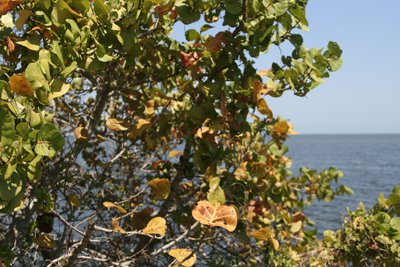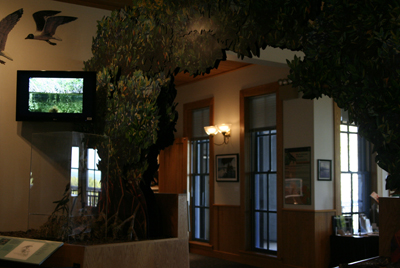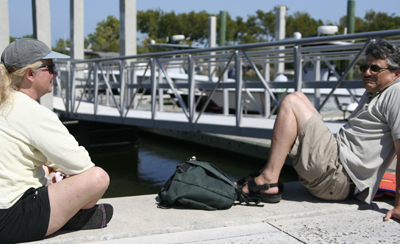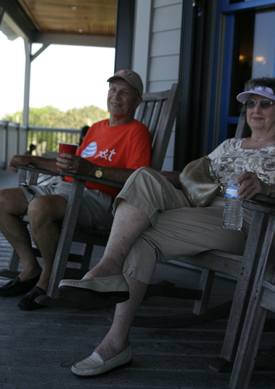
Exotic mangroves, unique bay encounters
HOMESTEAD, Fla. — Biscayne National Park holds a great deal of natural and human history and is credited for many ecological and mythological discoveries.
Amongst the most memorable and fascinating are the bay’s exotic mangroves, extraordinary encounters with wildlife and everyday experiences.
The mangroves have a sacred history within Biscayne National Park. The mangrove forest is one of the longest continuous stretches of mangroves left on the Florida’s East Coast.
| Red mangroves border the mainland walkway near the Biscayne National Park Visitor Center at Convoy Point (Photos by Jamie N. Stephens). |  |
“The mangroves are critical to us in several ways including protecting the land from the sea and vice versa. Actually in Miami-Dade County it’s illegal to cut down mangroves because of their incredible value,” said Gary Bremen, Biscayne National Park spokesperson and interpretive ranger.
“With their impenetrable root system these mangroves help to keep Biscayne’s waters clean and clear by slowing the water that flows into the bay from the land, allowing the sediment carried by the runoff to settle out. The leg-like network offers protection from erosion by wind and waves, as well as a place to explore the transition from forest to bay,” said Bremen.
Not to mention, Biscayne National Park’s mangrove-fringed shoreline provides habitats for hundreds of species including the mangrove cuckoo, the mangrove periwinkle, the flat tree oyster, the mangrove water snake and the mangrove crab; and as the very foundation of the food chain, supports thousands more which is illustrated in the Biscayne National Park Visitor Center exhibition area.
Essentially, these unique trees share an ability to grow in salty, tropical, periodically submerged conditions that would kill most plants.
 |
Biscayne National Park Visitor Center art display is adapted from real-life mangroves along the shores. |
At Biscayne you’ll find three species of mangrove trees: red, white and black. The mangroves are known around the park as “freaks of nature,” primarily because of the tall, arch-stilt like roots of the red mangroves that poke out of the water. These often grow down into the water from overhead branches. And the black mangroves’ roots appear as cigar-like “pneumatophores” sticking out of the soil all around the trunk.
These “snorkel-roots” can extend six or more inches above the saturated soil, allowing the submerged roots to obtain surface oxygen even as the tide comes in. The white mangrove, is freakishly unique because, out of all the mangroves that have trouble with cold weather and freezes; the white mangrove is the least cold tolerant of the three.
Aside from the major impact of the treasured mangroves, the park serves as an entry to some very interesting people, practices and pieces of bizarre history.
All kinds of uncommon activities have occurred at the park, including random waterside baptisms where visitors hear women screaming early on Sunday mornings or the mysterious, ancient bottled notes and trinkets that wash ashore or even the Cuban and Haitian rafters that arrive in the park every blue moon.
Bremen calls many of these random findings “gifts from the sea.”
As he talked, Bremen recalled one particular bizarre encounter.
| Art Goldsmith, a northern Canadian tourist, becomes acquainted with Cathy Vreid, a Hollywood, Fla., native as they sit on the Convoy Point walkway after a long day of kayaking in Biscayne National Park |  |
“One weekend as I was giving a “Trash is Bad” park presentation to a group of kids, a young man pointed out an odd object floating against the shore. As I retrieved the duct-taped, brown paper bag, I noticed a container filled with a yellow, sweet and sticky liquid inside.
“After putting on gloves, I preceded to un-wrap the concoction. Inside the container appeared to be two dolls, one male and one female, tied together face to face, with the female doll’s arm twisted behind her back. After some research I immediately contacted a Santerian (syncretic religion of West African and Caribbean origin) expert from an online message board and inquired about the strange discovery.
“The Santerian, a New Orleans native, assured me that this was an ancient love spell and that the yellow substance was honey which signified a promised life of sweetness; the female doll’s arm tied back was an effort to twist her arm into marrying the male doll and that if I didn’t want to disrupt the love spell, I should immediately throw the findings back into the ocean. Needless to say, I couldn’t throw it back because of littering issues, but I promised I’d secure it in a safe place which I hold today,” said Bremen.
Nevertheless, many first-time visitors like Cathy Vreid of Hollywood, Fla., claim that though she hoped to see some bizarre happenings; so far Biscayne National Park seemed to be fairly normal.
“I’ve been out on the water kayaking all day, excited to see all the exotic wildlife and tourism and honestly, I haven’t seen any sting rays, crocodiles, manatees or anything outside the regular yet. But, overall, I enjoyed the educational aspect of the park,” said Vreid.
Art Goldsmith, a northern Canadian tourist, who became acquainted with Vreid after his kayaking venture agreed that he was somewhat disappointed in the mellowness of the park that afternoon, especially after all the extraordinary sightseeing he anticipated upon his long arrival.
| Sitting on the Visitor Center porch overlooking the bay, Palmetto Bay residents Joanne Repetski reflect on their time as volunteers at Biscayne National Park. |  |
“The weather in Canada is below freezing right now because it’s mid-winter, so even though I didn’t see any eccentrics today, in the end I really can’t complain. Not to mention, I’ve been in South Florida on vacation for about a month now—so I’m content to say the least,” said Goldsmith.
To the contrary, some visitors have no preferences or expectations of the park and visit simply to bask in the ambiance, appreciate the scenery and spend time with family or friends.
“This is my second time here at the park and not only is the view nice but it’s also pretty relaxing. Just being here with my brother and father, fishing, having picnics and playing sports is special to me. I can’t wait to bring my kids here someday,” said Michael Arenas, 13, a student at West Miami Middle School.
Similarly, Walt and Joanne Repetski, nearby Palmetto Bay residents and active life members of the national AT&T Retired Pioneers volunteer network, have a deep attachment to the park as they helped build the walkway that surrounds the mainland. Though originally from West Virginia, the Repetskis have lived in South Florida since 1957 and consider it home.
“As active life members of AT&T Pioneers Retired Pioneers, we’ve volunteered in environmental projects for both Everglades and Biscayne national parks and have even assisted the University of Miami students in humanity projects such as the 600 medical teddy bears we recently helped distribute,” said Walt Repetskis.
Married for 56 years, visitors such as the Repetskis don’t take for granted what environmental oases such as Biscayne National Park has to offer.
So, whether it’s the welcoming people and climate, the exotic wildlife and mangroves, or even the extraordinary history and discoveries, Biscayne National Park is a learning environment in which many visitors will remember forever.
If You Go
- Address: 9700 SW 328th St., Homestead, Fla. 33033.
- Directions: From Miami, take Florida’s Turnpike south to Speedway Boulevard, and turn left (south). Continue four miles on Speedway Boulevard to North Canal Drive and turn left (east). Follow Canal Drive another four miles to the park entrance. From Homestead (about nine miles), take SW 328th Street (North Canal Drive) to the park entrance at Convoy Point.
- Hours: Convoy Point: daily from 7 a.m. to 5:30 p.m., the Dante Fascell Visitor Center: daily from 9 a.m. to 5.p.m., Water portion: 24 hours a day.
- Visitor Information: 305-230-PARK (305-230-7275).
- Tours: Boat tours, snorkeling and island tours: 305-230-1100.
- If you are interested in becoming a field inventory participant, visit http://www.nationalgeographic.com/field/projects/bioblitz.html for more information.

Comments are Closed